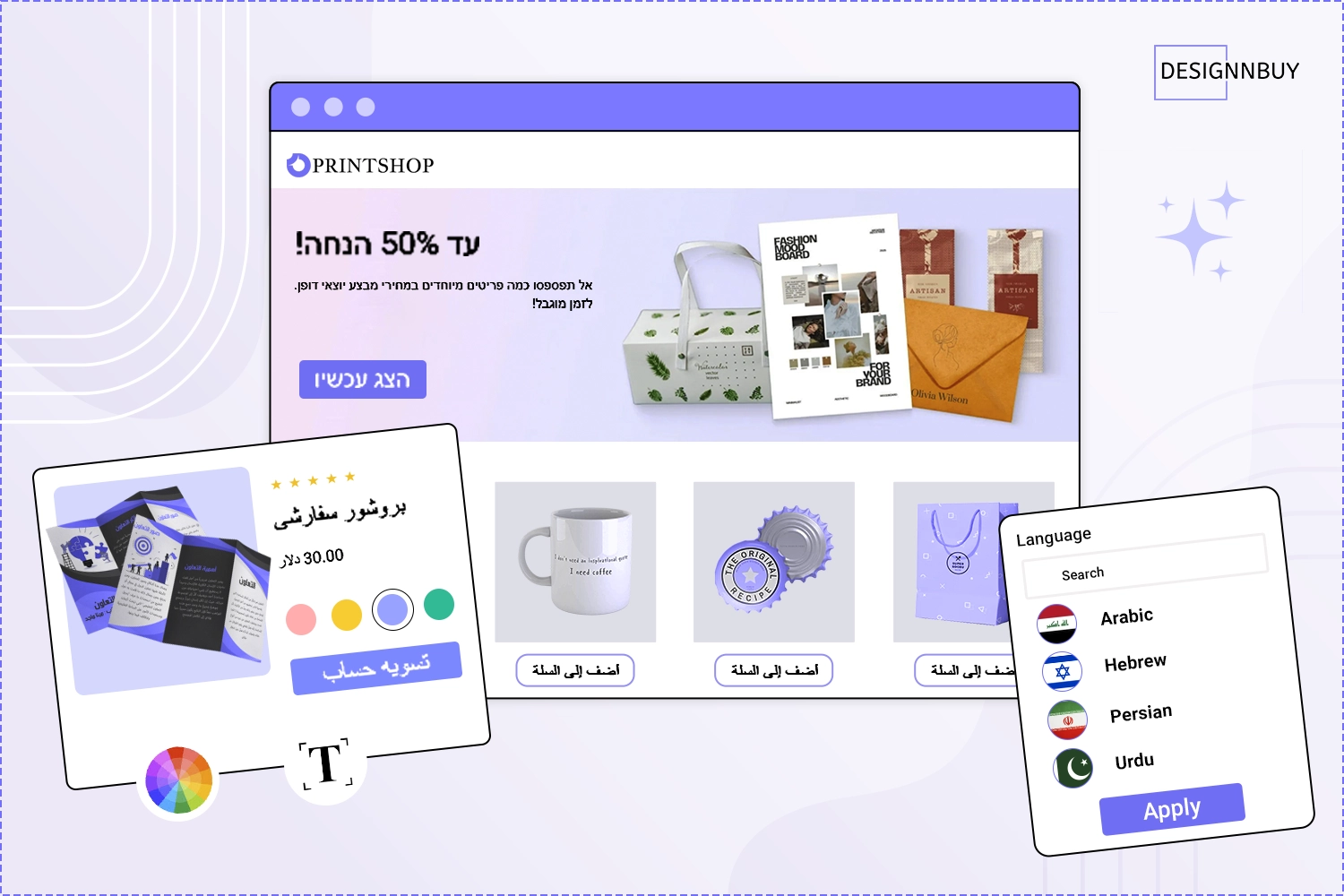Ever tried reading something that feels completely backward? That’s what happens when websites and tools ignore Right-to-Left (RTL) languages like Arabic, Persian, or Hebrew.
For businesses targeting Middle Eastern markets, proper RTL support isn’t optional but essential.
In this edition of DesignNBuy Expert Interview Series, we talk to Arash Nikdast, a digital marketing expert with over 15 years in the print industry.
He shares why RTL matters, how it shapes customer experience, and what printers need to succeed online.
Expert Tips to Grow Your Print Business with RTL Language Support
We’ll discuss how supporting Right-to-Left languages like Arabic and Hebrew can boost customer experience, minimize errors, and drive global growth
1. Can You Briefly Introduce Yourself and Your Background in Printing and eCommerce?
I am Arash Nikdast, a digital marketer with a focus on implementing digital marketing processes, automation, and workflow optimization in the print and packaging industry.
With over 15 years of specialized experience in marketing and sales within this sector, I have realized that digital media plays a crucial role in enhancing productivity and driving business growth. This perspective led me to enter the field of digital marketing, with the aim of contributing to the improvement and development of businesses in this industry.
I completed my undergraduate and master’s degree in graphic design and Print Industry Management and earned an MBA with a concentration in Marketing from the University of Tehran’s Faculty of Management.
My master’s thesis, titled “Examining the Relationship Between the Implementation of Web-to-Print Software Systems and Marketing Performance from the Perspective of Iranian Print Industry Experts,” and several related publications have further solidified my expertise.
Ultimately, with a focus on digital marketing, I have successfully promoted and implemented digital marketing processes within the print industry through teaching and conducting educational courses, thereby helping to advance this sector.
2. What is RTL (Right-to-Left) language support, and why is it important for Middle Eastern print businesses?
Right-to-Left (RTL) language support encompasses a set of technical and design configurations essential for proper display of languages like Persian, Arabic, and Hebrew.
This support must manage text direction, element alignment, numeral/date display, and overall UI layout from right-to-left. For printing businesses targeting Middle Eastern markets, this feature is critical because neglecting it leads to fundamental flaws in printed products.
For instance, an Arabic brochure with left-aligned text appears unprofessional and may completely distort the message. From a commercial perspective, lacking RTL support means losing substantial market share in regions where this feature is indispensable.
3. What language or localization challenges do Middle Eastern printers face when moving online?
Middle Eastern printers face multiple challenges when transitioning to web-to-print platforms. Primary technical hurdles include proper RTL text rendering across different browsers, as many CMS platforms lack native RTL support.
Integrating local payment gateways tailored for regional markets also requires special configurations. From a management standpoint, training staff on bidirectional systems and convincing traditional clients to adopt online platforms present significant obstacles.
Process-related challenges include: sequencing pre-press, printing, and post-press workflows; absence of systematic digital marketing; inflexible order forms; lack of standardized order management/production planning systems; and missing real-time tracking for managers. While this digital transformation is costly initially, it ultimately enhances productivity and reduces operational expenses.
4. How does RTL support improve the buying experience on eCommerce storefronts?
RTL support dramatically improves the online shopping experience for Persian, Arabic, and Hebrew speakers. When users encounter interfaces matching their natural reading patterns, they experience greater comfort and trust.
This leads to increased session duration, lower bounce rates, and higher conversion rates. For example, placing key buttons like “Purchase” or “Checkout” on the right side enables instinctive discovery. Proper display of localized product details (like Hijri dates or Eastern numerals) also prevents transactional errors.
5. Why should online design tools support RTL, and how does it benefit printers and customers?
Online design tools with RTL capabilities are strategically vital for printing businesses. They allow customers to create professional designs without technical hurdles. For businesses, this significantly reduces technical support volume by preempting text-direction errors. End-users benefit through time/cost savings, as they can customize products without mastering complex design software—particularly valuable for SMEs with limited design budgets.
Take Your Print Shop Global with Seamless RTL Support
Experience how DesignNBuy’s web to print solution simplifies RTL languages and localization.
6. How crucial are pre-designed RTL templates, and what should businesses keep in mind?
Pre-designed RTL templates are among the most effective ways to streamline customer design processes. These templates not only drastically reduce design time but also prevent common errors.
Key considerations when creating them include allocating 20-30% more space for Arabic/Persian text; selecting fonts with complete Arabic diacritic support; and using culturally appropriate color schemes (e.g., Islamic green tones in Muslim markets). Statistics show such templates can save 50% design time and reduce pre-press errors by 30%.
7. Why is it important to generate print-ready RTL files directly from a web-to-print platform?
Receiving print-ready RTL files directly compatible with printing equipment is paramount. This feature reduces prepress time while preventing potential errors. Print-ready files must automatically apply all RTL technical requirements including text direction, alignment, and font management.
Even minor RTL configuration errors can cause significant material waste—for example, reversed Arabic text ruins products and wastes ink/paper. Therefore, full integration between web-to-print platforms and printing devices is a necessary investment for modern print shops.
8. How do you see RTL support evolving with globalization and digital transformation?
The future of RTL support in printing is deeply intertwined with globalization and digital transformation trends. As e-commerce grows and demand for personalized printing increases, advanced RTL text management solutions will become crucial.
Emerging technologies like AI are expected to automate bidirectional text layout processes, while new international standards will better integrate RTL systems across the print value chain. These developments will empower Middle Eastern printers to compete more effectively globally.
9. What advice would you give Middle Eastern printers about RTL support and localization?
For Middle Eastern printers going online, proper RTL implementation should be prioritized. First step is selecting a natively RTL-compatible web-to-print platform—many foreign systems claiming RTL support still display texts incorrectly.
Conducting pilot tests with actual local content is recommended before full deployment. Staff training on bidirectional systems is equally essential. Strategically, gradual localization focusing on high-traffic sections (product pages/cart) works best. Collaborating with key clients for continuous feedback is vital for success.
10. Any final thoughts on the broader impact of RTL support in the print industry?
RTL support’s importance for Middle Eastern printers extends beyond technical aspects into cultural/social dimensions. It demonstrates respect for cultural identity and deep market understanding. For global businesses, it serves as competitive advantage when entering Middle Eastern markets.
Crucially, RTL shouldn’t be treated as an add-on but as core to digital strategy. Long-term, printers mastering RTL implementation will gain regional dominance and potentially become global benchmarks. Establishing regional consortiums to standardize RTL printing practices is highly recommended.
The Bottom Line: RTL Done Right = Business Growth

At DesignNBuy, we know that succeeding іn eCommerce means understanding your audience and for Middle Eastern markets, RTL support іs essential.
As Arash explained, it’s not just about aligning text; it’s about building trust, saving time, and avoiding costly mistakes. Whether you’re a print shop going digital оr a global brand expanding into new regions, getting RTL right can set you apart.
Ready tо grow your business? With tools like DesignNBuy’s web to print solutions, adding RTL support іs simpler than you think. It’s about making smart choices today tо connect with more customers tomorrow. After all, the best designs speak the language оf the people they serve.
Stay tuned tо DesignNBuy’s Expert Interview Series for more tips tо boost your business!
Need Help with RTL Implementation on Your Website?
Our experts are here to guide you through RTL implementation and localization strategies




